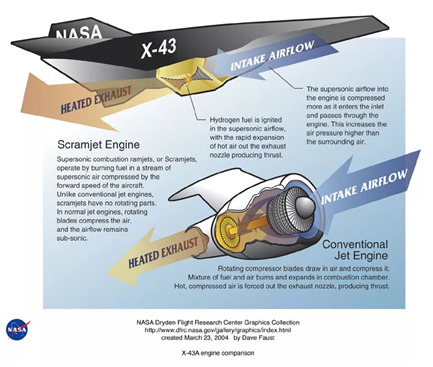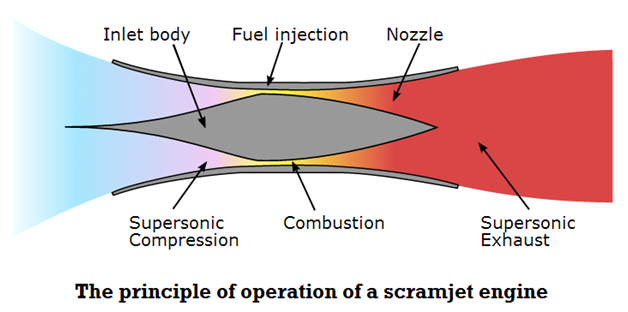ISRO’s hot test of Scramjet engine success
- Recently, The Indian Space Research Organisation (ISRO) has successfully conducted the Hot Test of Scramjet Engine.
What is a Scramjet Engine?
- A scramjet, also known as a supersonic-combustion ramjet, is a type of ramjet engine where the airflow remains supersonic, or faster than the speed of sound.
- A scramjet lacks a shock cone and instead slows the airflow utilising shockwaves generated by its ignition source.
- As a result, the scramjet can run efficiently at very high speeds.
- Vehicles powered by scramjets are expected to travel at least as fast as Mach 15.
Difference Between Ramjet and Scramjet
- A scramjet is a ramjet with supersonic combustion. In ordinary ramjets, the air is decelerated to subsonic velocities before combustion, but this is not the case in a scramjet.
- Ramjets have a velocity range of 1 to 6 Mach in theory, but Scramjets have a range of 12 to 24 Mach in theory.
- Ramjets and scramjets can’t produce thrust at zero velocity, they need a lot of airflow to start.
- Scramjets have a higher specific impulse than Ramjet.
- Owing to subsonic combustion, Ramjet has greater efficiency and operability than Scramjet, which has a lesser efficiency due to supersonic combustion.
The main processes in a Jet Engine
A Jet Engine has 3 main processes:
- COMPRESSION
It increases the pressure of the air trapped inside the chamber.
- COMBUSTION
It increases the temperature of the air-fuel mixture by releasing heat energy from the fuel.
- EXHAUST
It increases the velocity of the exhaust gases, thereby powering the vehicle.(Newton’s third law of motion)
Types of Jet Engines
The general operation of gas turbines and jet engines is the same. Therefore, they all have five essential parts in common: an inlet, a compressor, a combustion chamber, and a turbine, all of which are arranged in that precise order and connected by a driveshaft. Jet engines are similar, however they differ in the extra parts they have. The main types of Jet engines based on how air is compressed in the engine are as below:
- TURBO JET: Turbo jet engine is an air-breathing jet engine. This is one of the most common types of jet engines. It is still widely used in airplanes.
- TURBOFAN ENGINES: Turbofans differ from the turbojets in the way they have an additional component – a fan. The fan sucks in the air and then further gets compressed and combustion takes place in the burner.
- RAMJET: High-speed forward motion is used to compress the air (no compressor). Fuel is injected into the combustion chamber where it mixes with the hot compressed air and ignites. The average speed of Ramjet is 3-6 Mach. But the ramjet efficiency starts to drop when the vehicle reaches hypersonic speeds.
- SCRAMJET: Here also, the high-speed forward motion is used to compress the air (no compressor), but it is an improvement over the ramjet engine as it efficiently operates at hypersonic speeds and allows supersonic combustion. Speed is greater than 6 Mach (Six times the speed of Sound).
- DUAL MODE RAMJET (DMRJ): Type of jet engine where a ramjet transforms into scramjet over Mach 4-8 range, therefore, it can operate both in subsonic and supersonic combustion modes.
Scramjet (Supersonic Combustion Ramjet): Operation Details
- We require air, or oxygen, in order to ignite something. Even though they are going through the earth’s atmosphere, rockets often have oxygen in their oxidizer tanks. But it would be more energy-efficient if we could utilise atmospheric oxygen at this time. The significance of the Scramjet engine now comes into play.
- Hydrogen serves as the fuel and atmospheric air oxygen serves as the oxidizer in the ISRO-designed Scramjet engine. As a result, the system is more lighter, more effective, and economical.
- A test launch of the scramjet engine was conducted aboard the Rohini 560 sounding rocket (Research Rocket). The ISRO built and developed the RH 560, a two stage Advanced Technology Vehicle (ATV), to test scramjet engines. ATV is the heaviest sounding rocket ever created, weighing three tonnes.
India and Scramjet Technology
India had long before begun working on scramjet technology, and in 2006, we conducted ground tests to confirm the engine’s design. India is now the fourth nation to state that the Scramjet Engine testing was successful. In 1991, Russia was the first nation to assert that a scramjet had flown, and later, the US and the European Space Agency joined the exclusive club.
Scramjet – Challenges
- As was previously explained, the Scramjet employs its rapid forward motion to compress the air rather than a compressor. As a result, scramjet cannot generate effective thrust unless it is accelerated rapidly. We deduced from this that a scramjet engine cannot operate until it reaches a sufficient speed. This is Scramjet Engine’s primary flaw.
- As we are all aware, launch vehicles contain a number of stages, each with a unique engine. The engine is discarded to lighten the vehicle’s load once the fuel burns out in the first stage. Therefore, when the second stage ignition starts, the scramjet has enough speed to operate.
- Therefore ISRO used a scramjet engine at the second stage during the flight test and using this technique it excelled in overcoming the drawback.
- The design and development of the supersonic combustor, the development of materials able to withstand extremely high temperatures, the use of computational tools to simulate hypersonic flow, ensuring engine performance and operability across a wide range of flight speeds, proper thermal management, and ground testing of the engines are some of the additional technological challenges that ISRO overcame during the development of the Scramjet engine.
The importance of having this technology
- The amount of weight a launch vehicle can carry with a given amount of fuel determines how effective it is. Currently, 200 tonnes or roughly 85% of the mass of Indian rockets are carried by oxygen, which is burned off during the rocket’s atmospheric flight phase. Utilizing a scramjet would assist launch vehicles be lighter and move faster. India would be able to accomplish more with its constrained space budget.
- Antrix Corporation, the commercial arm of ISRO, has been launching satellites at a lesser price than other competitors as the satellite launching industry picks up steam. Utilizing a scramjet engine would help to maximise this while lowering the cost.
- Scramjet engine can be used to augment ISRO’s reusable launch vehicle (RLV).






